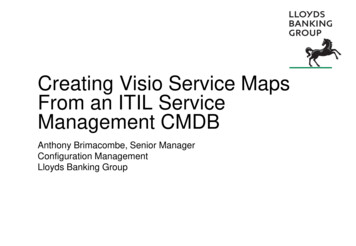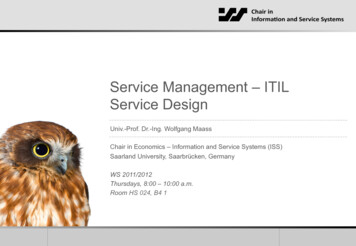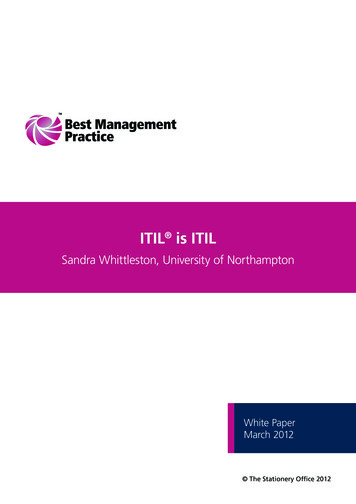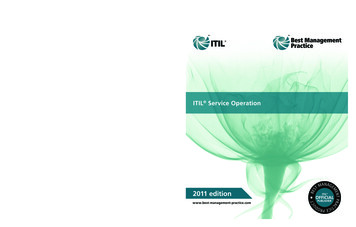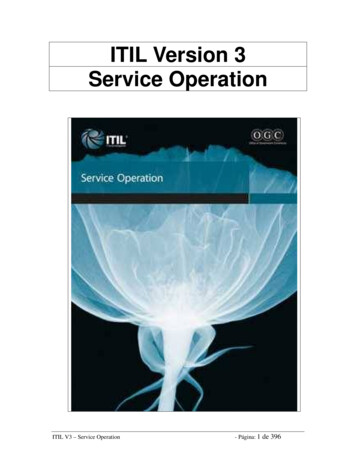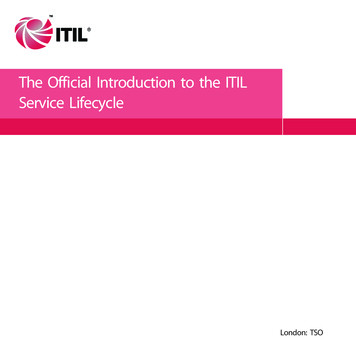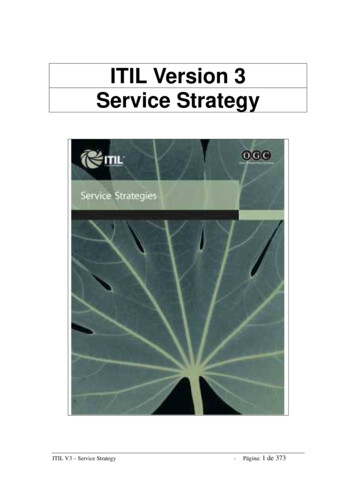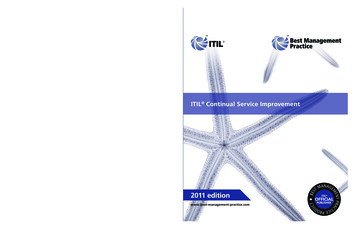
Transcription
Over time business requirements will change, so even withsuccessful service operations in place, there is still a needto re-align service provision with these changing businessneeds. What was good enough last year is unlikely to meetrequirements next year; therefore improvement opportunitiesneed to be constantly assessed and implemented. Thiscontinual cycle of service improvement will help protect againstlosing competitive edge and will ensure that the best possibleoutcomes are being achieved.ITIL Continual Service ImprovementITIL Continual Service Improvement focuses on the elementsinvolved in identifying and introducing a cycle of servicemanagement improvements. It provides structure for theapproach to assessing and measuring services, and helps youto avoid temporary fixes in favour of a continual improvementin quality that truly benefits the business customer.ITIL Continual Service Improvement2011 editionBESwww.best-management-practice.comNT PRACME9 780113 313082ANAGETMTUCISBN 978-0-11-331308-2E PRODTIC7188 ITIL CSI AN Cover V1 3.indd 1-311/07/2011 11:54
ITIL Continual Service ImprovementLondon: TSOCSI Prelims.indd 109/07/2011 09:46
Published by TSO (The Stationery Office) and available from:Onlinewww.tsoshop.co.ukMail, Telephone, Fax & E-mailTSOPO Box 29, Norwich, NR3 1GNTelephone orders/General enquiries: 0870 600 5522Fax orders: 0870 600 5533E-mail: customer.services@tso.co.ukTextphone 0870 240 3701TSO@Blackwell and other Accredited AgentsCustomers can also order publications from:TSO Ireland16 Arthur Street, Belfast BT1 4GDTel 028 9023 8451 Fax 028 9023 5401 Crown Copyright 2011This is a Crown copyright value added product, reuse of which requires a Licence from the Cabinet OfficeApplications to reuse, reproduce or republish material in this publication should be sent toThe Efficiency & Reform Group Service Desk, Cabinet Office, Rosebery Court, St Andrews Business Park,Norwich, Norfolk NR7 0HS Tel No: ( 44) (0)845 000 4999, E-mail: servicedesk@cabinet-office.gsi.gov.ukor complete the application form on the Cabinet Office website, Licensing section.Copyright in the typographical arrangement and design is vested in The Stationery Office Limited.Applications for reproduction should be made in writing to The Stationery Office Limited, St Crispins,Duke Street, Norwich, NR3 1PD.The Swirl logo is a trade mark of the Cabinet OfficeITIL is a registered trade mark of the Cabinet OfficePRINCE2 is a registered trade mark of the Cabinet OfficeM o R is a registered trade mark of the Cabinet OfficeP3O is a registered trade mark of the Cabinet OfficeMSP is a registered trade mark of the Cabinet OfficeMoV is a trade mark of the Cabinet OfficeMoP is a trade mark of the Cabinet OfficeThe OGC Official Product endorsement logo is a trade mark of the Cabinet OfficeOGC (former owner of Best Management Practice) and its functions have moved into the Cabinet Officepart of HM Government – www.cabinetoffice.gov.ukFirst edition Crown Copyright 2007Second edition Crown Copyright 2011First published 2011ISBN 9780113313082Printed in the United Kingdom for The Stationery OfficeMaterial is FSC certified and produced using ECF pulp.Sourced from fully sustainable forests.P002425506CSI Prelims.indd 2c70 07/1109/07/2011 09:46
ContentsList of figuresvList of troduction11.1 Overview31.2 Context623CSI Prelims.indd 31.3 ITIL in relation to other publicationsin the Best Management Practiceportfolio81.4 Why is ITIL so successful?81.5 Chapter summary10Service management as a practice112.1 Services and service management132.2 Basic concepts202.3 Governance and managementsystems252.4 The service lifecycle274563.11 Frameworks, models, standardsand quality systems423.12 CSI inputs and outputs44Continual service improvementprocesses454.1 The seven-step improvementprocess47Continual service improvementmethods and techniques715.1 Methods and techniques735.2 Assessments745.3 Benchmarking795.4 Service measurement855.5 Metrics915.6 Return on investment1065.7 Service reporting1115.8 CSI and other servicemanagement processes1125.9 Summary125Organizing for continual serviceimprovement1276.1 Organizational development1296.2 Functions1296.3 Roles1296.4 Customer engagement1386.5 Responsibility model – RACI1386.6 Competence and training139Technology considerations143Continual service improvementprinciples333.1 Continual service improvementapproach353.2 CSI and organizational change363.3 Ownership363.4 CSI register363.5 External and internal drivers373.6 Service level management377.1 Tools to support CSI activities1453.7 Knowledge management387.2 Summary1523.8 The Deming Cycle383.9 Service measurement383.10 IT governance42709/07/2011 09:46
iv Contents89Implementing continual serviceimprovement1538.1 Critical considerations forimplementing CSI1558.2 Where do I start?1558.3 Governance1568.4 CSI and organizational change1578.5 Communication strategy and plan1628.6 Summary164Challenges, risks and criticalsuccess factors1659.1 Challenges1679.2 Critical success factors1679.3 Risks1679.4 Summary168Afterword169Appendix A: Related guidance173A.1ITIL guidance and web services175A.2Quality management system175A.3Risk management176A.4Governance of IT176A.5COBIT176A.6ISO/IEC 20000 servicemanagement series177Environmental managementand green/sustainable IT177ISO standards and publicationsfor IT178ITIL and the OSI framework178A.7A.8A.9CSI Prelims.indd 4A.10 Programme and projectmanagement179A.11 Organizational change179A.12 Skills Framework for theInformation Age180A.13 Carnegie Mellon: CMMI and eSCMframework180A.14 Balanced scorecard180A.15 Six Sigma180Appendix B: Example of a continualservice improvement register183Appendix C: Risk assessment andmanagement187C.1 Definition of risk and riskmanagement189C.2 Management of Risk (M o R)189C.3 ISO 31000190C.4 ISO/IEC 27001191C.5 Risk IT192Appendix D: Examples of inputs andoutputs across the service lifecycle195Abbreviations and glossary199Index23909/07/2011 09:46
List of figuresFigure 1.1The ITIL service lifecycleFigure 1.2ITIL’s relationship with other BestManagement Practice guides9Conversation about the definitionand meaning of services14Logic of value creation throughservices18Sources of service managementpractice19Examples of capabilities andresources21Figure 2.5Process model21Figure 2.6The service portfolio and itscontents25Figure 2.7Architectural layers of an SKMS26Figure 2.8Plan-Do-Check-Act cycle27Figure 2.9Integration across the servicelifecycle30Figure 2.1Figure 2.2Figure 2.3Figure 2.4Figure 2.10 Continual service improvementand the service lifecycleFigure 3.133135Knowledge management leads tobetter IT decisions38Figure 3.3Why do we measure?39Figure 3.4The seven-step improvementprocess40Knowledge spiral – a gatheringactivity41Enterprise governance(source: CIMA)Figure 4.1Figure 4.2Figure 3.5Figure 3.6Figure 4.3Figure 4.4CSI Prelims.indd 5First- to fourth-order drivers64Figure 5.1The relationship of services,processes and systems77The value of a process versus thematurity of a process79Figure 5.3Availability reporting86Figure 5.4Service measurement model88Figure 5.5Technology domain versusservice management89Figure 5.6Service management model90Figure 5.7From vision to measurement92Figure 5.8Number of incidents opened byservice desk over time96Comparison of incidents openedand resolved on first contact bythe service desk96Figure 5.2Continual service improvementapproachFigure 3.2Figure 4.5Figure 5.9Figure 5.10 Deriving measurements andmetrics from goals andobjectivesFigure 5.11Reported outage minutes fora service99100Figure 5.12 IT balanced scorecard104Figure 5.13 The expanded incident lifecycle114Figure 5.14 Connecting business and servicecapacity management116Figure 5.15 Business capacity growth model117Figure 5.16 Connecting service and componentcapacity management11742Figure 5.17 Connecting businesses, serviceand component capacitymanagement117From vision to measurements50Figure 5.18 Capacity management activities120Monitoring and data collectionproceduresFigure 5.19 Sources of knowledge12355Figure 5.20 Reasons for a risk managementprocess124Common procedures forprocessing the data57Service level achievement chart62Figure 6.1Activities and skill levels neededfor continual serviceimprovement13409/07/2011 09:46
vi List of figuresFigure 6.2Service management roles andcustomer engagement139The application of thearchitectural layers of the CMS147Service-centric view of the ITenterprise151Process re-engineering changeseverything157Figure 8.2Vision becomes blurred163Figure 8.3CSI roles and inputs164Figure C.1The M o R framework190Figure C.2ISO 31000 risk managementprocess flow191ISACA Risk IT processframework193Figure 7.1Figure 7.2Figure 8.1Figure C.3CSI Prelims.indd 609/07/2011 09:46
viiList of tablesTable 2.1The processes described in eachcore ITIL publication29CSI inputs and outputs bylifecycle stage43Table 4.1Policy template example49Table 4.2Monitoring and data collectionproceduresTable 3.1Table 4.3Table 5.1Table 5.2Procedures for processing thedataPros and cons of assessmentapproachesTable 6.1Table 6.2555776Average results of over 100process assessments beforeimprovement84Table 5.3CMMI maturity model84Table 5.4Key performance indicators ofthe value of service managementprocesses90Table 5.5Table 5.6Table 5.7Table 5.8Table 5.9High-level goals and keyperformance indicatorsTable 6.5Table 6.6Table 6.8Table 6.991Table 8.1Examples of service qualitymetrics94Response times for three servicedesks97An example of a summary reportformat100Service report of outage minutescompared to goal101Percentage of incidents meetingtarget time for service restoration 101Table 5.11Sample key performanceindicators102Service desk balanced scorecardexample105Table 5.13SWOT analysis107Table 5.14Sample SWOT analysis for CSI107Table 5.15Departmental requirements116Table 5.16Risk register125CSI Prelims.indd 7Table 6.4Table 6.7Table 5.10Table 5.12Table 6.3Table 8.2Skills involved in Step 1 – Identifythe strategy for improvement135Skills involved in Step 2 – Definewhat you will measure135Skills involved in Step 3 – Gatherthe data135Skills involved in Step 4 – Processthe data135Skills involved in Step 5 – Analysethe information and data136Skills involved in Step 6 – Presentand use the information136Skills involved in Step 7 –Implement improvement136Comparison of CSI manager,service level manager, serviceowner and business relationshipmanager roles137An example of a simple RACImatrix140Eight steps that need to beimplemented, and the mainreasons why transformationefforts fail (from Kotter, 1996)158Table for sample communicationplan16309/07/2011 09:46
ForewordBack in the 1980s no one truly understood ITservice management (ITSM), although it wasclear that it was a concept that needed to beexplored. Hence a UK government initiative wasinstigated and ITIL was born. Over the years,ITIL has evolved and, arguably, is now the mostwidely adopted approach in ITSM. It is globallyrecognized as the best-practice framework. ITIL’suniversal appeal is that it continues to provide aset of processes and procedures that are efficient,reliable and adaptable to organizations of allsizes, enabling them to improve their own serviceprovision.Having progressed a service from strategy todesign through transition and then into liveoperation, where do we go then? Continual serviceimprovement (CSI) is the answer.One of the cornerstones of the ITIL service lifecycleis that we should always strive to improve, as todo otherwise leads to standing still, potentiallyfollowed by stagnation and ultimately death.Improvements can be a reduction in weaknesses oran enhancement of strengths, as well as adoptingnew approaches to existing activities. ITIL ContinualService Improvement offers guidance on ways tomeasure, review and act to identify and adoptimprovements in service provision. If you have notstarted your IT service management journey thenyou may find that this publication is a good placeto start, as you can use it to identify those areaswhere your organization will most benefit fromapplying service management practices.There is an associated qualification scheme so thatindividuals can demonstrate their understandingand application of the ITIL practices. So whetheryou are starting out or continuing along the ITILpath, you are joining a legion of individuals andorganizations who have recognized the benefits ofgood quality service and have a genuine resolve toimprove their service level provision.ITIL is not a panacea to all problems. It is, however,a tried and tested approach that has been provento work.I wish you every success in your servicemanagement journey.Frances ScarffHead of Best Management PracticeCabinet OfficeThe principles contained within ITIL ContinualService Improvement have been proven countlesstimes in the real world. We encourage feedbackfrom business and the ITSM community, as wellas other experts in the field, to ensure that ITILremains relevant. This practice of continual serviceimprovement is one of the cornerstones of the ITILframework and the fruits of this labour are herebefore you in this updated edition.CSI Prelims.indd 809/07/2011 09:46
Preface‘Learning is not compulsory neither is survival.’W Edwards DemingContact informationThis is the fifth book in the series of five ITIL corepublications containing advice and guidancearound the activities and processes associated withthe five stages of the service lifecycle. The primarypurpose of the continual service improvementstage of the service lifecycle is to learn fromexperience and to apply that learning in order tocontinually improve the quality of IT services andto optimize anagement-ITIL/Continual service improvement must permeateand become woven into every stage of theservice lifecycle and into every process, function,activity, tool, supplier and member of staff. Thiswill involve the establishment of appropriatemonitoring, measurement, analysis, reporting andimplementation of corrective actions to ensurethat the IT services being provided, as well asthe processes, tools and suppliers who deliverand operate them, remain fit for purpose or areupdated as required. It should also ensure that theoverall IT strategy itself remains robust, and thatthe knowledge, skills, qualifications and experienceof IT staff are updated and maintained as required.Full details of the range of material publishedunder the ITIL banner can be found at:If you would like to inform us of any changes thatmay be required to this publication, please logthem at:www.best-management-practice.com/changelog/For further information on qualifications andtraining accreditation, please visitwww.itil-officialsite.comAlternatively, please contact:APM Group – The Accreditor Service DeskSword HouseTotteridge RoadHigh WycombeBuckinghamshireHP13 6DGUKTel: 44 (0) 1494 458948Email: servicedesk@apmgroupltd.comContinual service improvement is cyclical in nature;there are periods of stability followed by moreimprovements, then a new level of stability isfollowed by more improvements and so on.ITIL Continual Service Improvement gives practicalguidance on how to assess the overall healthand maturity of an organization’s IT servicemanagement capabilities, and explains howcontinual service improvement is closely akinto quality management. Both are aligned to aPlan-Do-Check-Act cycle, so should be used inconjunction to achieve ongoing service quality tocontinually meet required business outcomes.CSI Prelims.indd 909/07/2011 09:46
Acknowledgements2011 EDITIONAuthors and mentorsVernon Lloyd (Fox IT)AuthorFor a full list of acknowledgements of the ATOsub-group at the time of publication, pleasevisit: Acknowledgements.aspxDavid Wheeldon(David Wheeldon IT Service Management)MentorWider teamShirley Lacy (ConnectSphere)The change advisory board (CAB) spentconsiderable time and effort reviewing all thecomments submitted through the change controllog and their hard work was essential to thisproject. Members of the CAB involved in thisreview included:Ashley Hanna (HP)Project mentorTechnical continuity editorOther members of the ITIL authoringteamThanks are due to the authors and mentors whohave worked on all the publications in the lifecyclesuite and contributed to the content in thispublication and consistency across the suite.They are:David Cannon (HP), Lou Hunnebeck (Third Sky),Anthony T. Orr (BMC Software), Stuart Rance (HP),Colin Rudd (IT Enterprise Management ServicesLtd (ITEMS)) and Randy Steinberg (MigrationTechnologies Inc.).Project governanceMembers of the project governance team included:Jessica Barry, APM Group, project assurance(examinations); Marianna Billington, itSMFI, senioruser; Emily Egle, TSO, team manager; JanineEves, TSO, senior supplier; Phil Hearsum, CabinetOffice, project assurance (quality); Tony Jackson,TSO, project manager; Paul Martini, itSMFI, senioruser; Richard Pharro, APM Group, senior supplier;Frances Scarff, Cabinet Office, project executive;Rob Stroud, itSMFI, senior user; Sharon Taylor,Aspect Group Inc., adviser to the project board(technical) and the ATO sub-group, and adviser tothe project board (training).For more information on the ATO sub-group inted.aspxCSI Prelims.indd 10Change advisory boardDavid Cannon, Emily Egle, David Favelle, AshleyHanna, Kevin Holland, Stuart Rance, Frances Scarffand Sharon Taylor.Once authors and mentors were selected for the2011 update, a revised CAB was appointed andnow includes:Emily Egle, David Favelle, Phil Hearsum, KevinHolland and Frances Scarff.ReviewersClaire Agutter, IT Training Zone; Deborah L.Anthony, HP; Nancy Arellano, Tata ConsultancyServices; Ernest R. Brewster, Independent; DavidM. Brink, Solutions3; Jeroen Bronkhorst, HP; TonyBrough, DHL Supply Chain; Janaki Chakravarthy,Independent; Christiane Chung Ah Pong, NCSPte Ltd, Singapore; Federico Corradi, Cogitek;Jenny Dugmore, Service Matters; Frank Eggert,MATERNA GmbH; David Favelle, UXC Consulting/Lucid IT; Ryan Fraser, HP; Jenni Garvie; John Groom,WestGroom Consulting; Jabe Hickey, IBM; KevinHolland, NHS Connecting for Health; Kai Holthaus,Third Sky; Steve Ingall, iCore-ltd; Brad Laatsch,HP; Chandrika Labru, Tata Consultancy Services;Reginald Lo, Third Sky; Brian McCabe, HitachiConsulting; Jane McNamara, Lilliard AssociatesLtd; Judit Pongracz, ITeal Consulting; MuraliRamakrishnan, Process-Symphony; Daniel Ramalho,Unilever Global IT Services; Devang Raval, QuintWellington Redwood; Noel Scott, Symantec; MoiraShaw, Steria; Arun Simha, L-3 Communications09/07/2011 09:46
Acknowledgements xiSTRATIS; Helen Sussex, Logica; J.R. Tietsort, MicronTechnology; Ken Turbitt, Service ManagementConsultancy (SMCG) Ltd; A.D. Williams, CornellUniversity; Neil Wilson, The Grey MattersEducation Ltd2007 EDITIONChief architect and authorsThanks are still due to those who contributed tothe 2007 edition of Continual Service Improvement,upon which this updated edition is based.Sharon Taylor (Aspect Group Inc)Chief architectGary Case (Pink Elephant)AuthorGeorge Spalding (Pink Elephant)AuthorAll names and organizations were correct atpublication in 2007.For a full list of all those who contributed to the2007 and 2011 editions of Service Strategy, ServiceDesign, Service Transition, Service Operation andContinual Service Improvement, please go onAcknowledgements.aspxCSI Prelims.indd 1109/07/2011 09:46
CSI Prelims.indd 1209/07/2011 09:46
IntroductionCSI Chapter 01.indd 1109/07/2011 09:48
CSI Chapter 01.indd 209/07/2011 09:48
31 IntroductionITIL is part of a suite of best-practice publicationsfor IT service management (ITSM).1 ITIL providesguidance to service providers on the provision ofquality IT services, and on the processes, functionsand other capabilities needed to support them.ITIL is used by many hundreds of organizationsaround the world and offers best-practice guidanceapplicable to all types of organization thatprovide services. ITIL is not a standard that has tobe followed; it is guidance that should be readand understood, and used to create value for theservice provider and its customers. Organizationsare encouraged to adopt ITIL best practices and toadapt them to work in their specific environmentsin ways that meet their needs.key principles, required processes and activities,organization and roles, technology, associatedchallenges, critical success factors and risks. Theservice lifecycle uses a hub-and-spoke design, withservice strategy at the hub, and service design,transition and operation as the revolving lifecyclestages or ‘spokes’. Continual service improvement(CSI) surrounds and supports all stages of theservice lifecycle. Each stage of the lifecycle exertsinfluence on the others and relies on them forinputs and feedback. In this way, a constant setof checks and balances throughout the servicelifecycle ensures that as business demand changeswith business need, the services can adapt andrespond effectively.ITIL is the most widely recognized framework forITSM in the world. In the 20 years since it wascreated, ITIL has evolved and changed its breadthand depth as technologies and business practiceshave developed. ISO/IEC 20000 provides a formaland universal standard for organizations seeking tohave their service management capabilities auditedand certified. While ISO/IEC 20000 is a standard tobe achieved and maintained, ITIL offers a body ofknowledge useful for achieving the standard.In addition to the core publications, there is also acomplementary set of ITIL publications providingguidance specific to industry sectors, organizationtypes, operating models and technologyarchitectures.In 2007, the second major refresh of ITIL waspublished in response to significant advancementsin technology and emerging challenges for ITservice providers. New models and architecturessuch as outsourcing, shared services, utilitycomputing, cloud computing, virtualization, webservices and mobile commerce have becomewidespread within IT. The process-based approachof ITIL was augmented with the service lifecycleto address these additional service managementchallenges. In 2011, as part of its commitmentto continual improvement, the Cabinet Officepublished this update to improve consistency acrossthe core publications.1.1 OVERVIEWITIL Continual Service Improvement provides bestpractice guidance for the CSI stage of the ITILservice lifecycle. Although this publication can icestrategyServicedesignServiceoperationThe ITIL framework is based on the five stagesof the service lifecycle as shown in Figure 1.1,with a core publication providing best-practiceguidance for each stage. This guidance includesITSM and other concepts from this chapter are described inmore detail in Chapter 2.1CSI Chapter 01.indd 3Figure 1.1 The ITIL service lifecycle09/07/2011 09:48
4 Introductionread in isolation, it is recommended that it is usedin conjunction with the other core ITIL publications.1.1.1 Purpose and objectives of CSIThe purpose of the CSI stage of the lifecycle isto align IT services with changing business needsby identifying and implementing improvementsto IT services that support business processes.These improvement activities support the lifecycleapproach through service strategy, servicedesign, service transition and service operation.CSI is always seeking ways to improve serviceeffectiveness, process effectiveness and costeffectiveness.In order to identify improvement opportunities,the measurement of current performance is animportant factor. Consider the following sayingsabout measurements and management:You cannot manage what you cannot control.You cannot control what you cannot measure.You cannot measure what you cannot define.If services and processes are not implemented,managed and supported using clearly definedgoals, objectives and relevant measurements thatlead to actionable improvements, the business willsuffer. Depending upon the criticality of a specificIT service to the business, the organization couldlose productive hours, experience higher costs,suffer loss of reputation or, perhaps, even riskbusiness failure. Ultimately it could also lead toloss of customer business. That is why it is criticallyimportant to understand what to measure, whyit is being measured and what the successfuloutcome should be.The objectives of CSI are to:n Review, analyse, prioritize and makerecommendations on improvementopportunities in each lifecycle stage: servicestrategy, service design, service transition,service operation and CSI itselfn Review and analyse service level achievementn Identify and implement specific activities toimprove IT service quality and improve theefficiency and effectiveness of the enablingprocessesn Improve cost effectiveness of delivering ITservices without sacrificing customer satisfactionCSI Chapter 01.indd 4n Ensure applicable quality management methodsare used to support continual improvementactivitiesn Ensure that processes have clearly definedobjectives and measurements that lead toactionable improvementsn Understand what to measure, why it is beingmeasured and what the successful outcomeshould be.1.1.2 ScopeITIL Continual Service Improvement providesguidance in four main areas:n The overall health of ITSM as a disciplinen The continual alignment of the service portfoliowith the current and future business needsn The maturity and capability of the organization,management, processes and people utilized bythe servicesn Continual improvement of all aspects of the ITservice and the service assets that support them.To implement CSI successfully it is important tounderstand the different activities that need to beapplied. The following activities support CSI:n Reviewing management information and trendsto ensure that services are meeting agreedservice levelsn Reviewing management information and trendsto ensure that the output of the enablingprocesses are achieving the desired resultsn Periodically conducting maturity assessmentsagainst the process activities and associatedroles to demonstrate areas of improvement or,conversely, areas of concernn Periodically conducting internal audits verifyingemployee and process compliancen Reviewing existing deliverables forappropriatenessn Periodically proposing recommendations forimprovement opportunitiesn Periodically conducting customer satisfactionsurveysn Reviewing business trends and changedpriorities, and keeping abreast of businessprojectionsn Conducting external and internal service reviewsto identify CSI opportunities09/07/2011 09:48
Introduction n Measuring and identifying the value created byCSI improvements.Adopting and implementing standard andconsistent approaches for CSI will:These activities do not happen automatically. Theymust be owned by individuals within the serviceprovider organization who are empowered tomake things happen. They must also be plannedand scheduled on an ongoing basis. By default,‘improvement’ becomes a process within ITSMwith defined activities, inputs, outputs, rolesand reporting levels. CSI must ensure that ITSMprocesses are developed and deployed in supportof an end-to-end service management approachto business customers. It is essential to develop anongoing continual improvement strategy for eachof the processes as well as for the services that theysupport.n Lead to a gradual and continual improvement inservice quality, where justifiedn Ensure that IT services remain continuouslyaligned to business requirementsn Result in gradual improvements in costeffectiveness through a reduction in costs and/or the capability to handle more work at thesame costn Use monitoring and reporting to identifyopportunities for improvement in all lifecyclestages and in all processesn Identify opportunities for improvementsin organizational structures, resourcingcapabilities, partners, technology, staff skills andtraining, and communications.The deliverables of CSI must be reviewed on anongoing basis to verify completeness, functionalityand feasibility, and to ensure that they remainrelevant and do not become stale and unusable.It is also important to ensure that monitoring ofquality indicators and metrics will identify areas forprocess improvement.Since any improvement initiative will more thanlikely necessitate changes, specific improvementswill need to follow the defined changemanagement process.1.1.3 UsageITIL Continual Service Improvement provides accessto proven best practice based on the skill andknowledge of experienced industry practitionersin adopting a standardized and controlledapproach to service management. Although thispublication can be used and applied in isolation, itis recommended that it is used in conjunction withthe other core ITIL publications. All of the corepublications need to be read to fully appreciateand understand the overall lifecycle of services andIT service management.1.1.4 Value to businessSelecting and adopting the best practice asrecommended in this publication will assistorganizations in delivering significant benefits.It will help readers to set up CSI and the processthat supports it, and to make effective use of theprocess to facilitate the effective improvement ofservice quality.CSI Chapter 01.indd 551.1.5 Target audienceITIL Continual Service Improvement is relevantto organizations involved in the development,delivery or support of services, including:n Service providers, both internal and externaln Organizations that aim to improve servicesthrough the effective application of servicemanagement and service lifecycle processes toimprove their service qualityn Organizations that require a consistentmanaged approach across all service providers ina supply chain or value networkn Organizations t
A.1 ITIL guidance and web services 175 A.2 Quality management system 175 A.3 Risk management 176 A.4 Governance of IT 176 A.5 COBIT 176 A.6 ISO/IEC 20000 service management series 177 A.7 Environmental management and green/sustainable IT 177 A.8 ISO standards and publications for I



